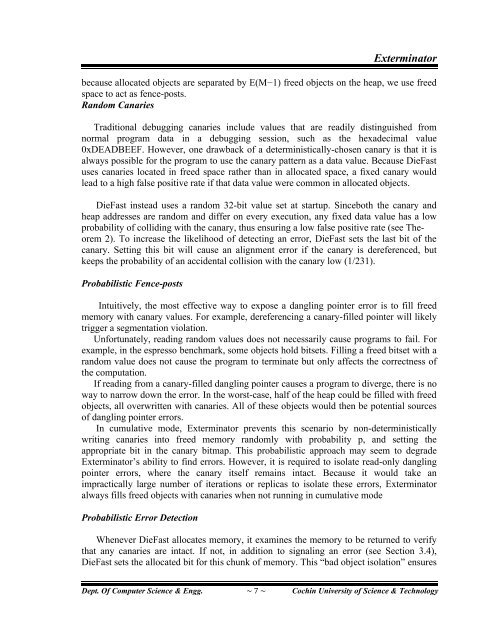Exterminator- A ... with High Probability.pdf - DSpace at CUSAT ...
Exterminator- A ... with High Probability.pdf - DSpace at CUSAT ...
Exterminator- A ... with High Probability.pdf - DSpace at CUSAT ...
Create successful ePaper yourself
Turn your PDF publications into a flip-book with our unique Google optimized e-Paper software.
<strong>Extermin<strong>at</strong>or</strong><br />
because alloc<strong>at</strong>ed objects are separ<strong>at</strong>ed by E(M−1) freed objects on the heap, we use freed<br />
space to act as fence-posts.<br />
Random Canaries<br />
Traditional debugging canaries include values th<strong>at</strong> are readily distinguished from<br />
normal program d<strong>at</strong>a in a debugging session, such as the hexadecimal value<br />
0xDEADBEEF. However, one drawback of a deterministically-chosen canary is th<strong>at</strong> it is<br />
always possible for the program to use the canary p<strong>at</strong>tern as a d<strong>at</strong>a value. Because DieFast<br />
uses canaries loc<strong>at</strong>ed in freed space r<strong>at</strong>her than in alloc<strong>at</strong>ed space, a fixed canary would<br />
lead to a high false positive r<strong>at</strong>e if th<strong>at</strong> d<strong>at</strong>a value were common in alloc<strong>at</strong>ed objects.<br />
DieFast instead uses a random 32-bit value set <strong>at</strong> startup. Sinceboth the canary and<br />
heap addresses are random and differ on every execution, any fixed d<strong>at</strong>a value has a low<br />
probability of colliding <strong>with</strong> the canary, thus ensuring a low false positive r<strong>at</strong>e (see Theorem<br />
2). To increase the likelihood of detecting an error, DieFast sets the last bit of the<br />
canary. Setting this bit will cause an alignment error if the canary is dereferenced, but<br />
keeps the probability of an accidental collision <strong>with</strong> the canary low (1/231).<br />
Probabilistic Fence-posts<br />
Intuitively, the most effective way to expose a dangling pointer error is to fill freed<br />
memory <strong>with</strong> canary values. For example, dereferencing a canary-filled pointer will likely<br />
trigger a segment<strong>at</strong>ion viol<strong>at</strong>ion.<br />
Unfortun<strong>at</strong>ely, reading random values does not necessarily cause programs to fail. For<br />
example, in the espresso benchmark, some objects hold bitsets. Filling a freed bitset <strong>with</strong> a<br />
random value does not cause the program to termin<strong>at</strong>e but only affects the correctness of<br />
the comput<strong>at</strong>ion.<br />
If reading from a canary-filled dangling pointer causes a program to diverge, there is no<br />
way to narrow down the error. In the worst-case, half of the heap could be filled <strong>with</strong> freed<br />
objects, all overwritten <strong>with</strong> canaries. All of these objects would then be potential sources<br />
of dangling pointer errors.<br />
In cumul<strong>at</strong>ive mode, <strong>Extermin<strong>at</strong>or</strong> prevents this scenario by non-deterministically<br />
writing canaries into freed memory randomly <strong>with</strong> probability p, and setting the<br />
appropri<strong>at</strong>e bit in the canary bitmap. This probabilistic approach may seem to degrade<br />
<strong>Extermin<strong>at</strong>or</strong>’s ability to find errors. However, it is required to isol<strong>at</strong>e read-only dangling<br />
pointer errors, where the canary itself remains intact. Because it would take an<br />
impractically large number of iter<strong>at</strong>ions or replicas to isol<strong>at</strong>e these errors, <strong>Extermin<strong>at</strong>or</strong><br />
always fills freed objects <strong>with</strong> canaries when not running in cumul<strong>at</strong>ive mode<br />
Probabilistic Error Detection<br />
Whenever DieFast alloc<strong>at</strong>es memory, it examines the memory to be returned to verify<br />
th<strong>at</strong> any canaries are intact. If not, in addition to signaling an error (see Section 3.4),<br />
DieFast sets the alloc<strong>at</strong>ed bit for this chunk of memory. This “bad object isol<strong>at</strong>ion” ensures<br />
Dept. Of Computer Science & Engg. ~ 7 ~ Cochin University of Science & Technology
















